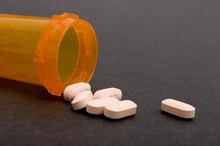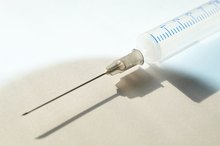What Does it Mean If I Have a Testosterone Level of Below 200?
A testosterone level below 200 is called hypogonadism, and can lead to several medical conditions, including fatigue, low sex drive and reduced muscle mass 2. Risk for developing hypogonadism increases with excess weight gain, trauma and severe illness 2. Both men and women can develop low levels of testosterone, and treatment is usually in the form of hormone replacement therapy. If you think you suffer from hypogonadism, speak with your doctor for a proper diagnosis and treatment plan 2.
Definition
Hypogonadism occurs when the primary sex organs fail to produce testosterone, or when the hypothalamus or pituitary glands fail to release appropriate levels of gonadotropin-releasing hormone, luteinizing hormone or follicle stimulating hormone 2. Hypogonadism can occur in both men and women 12. A testosterone level above 200 nanograms per deciliter (ng/dL) in men is considered the low end of normal. In women, normal testosterone levels may be above 15 ng/dL, but a clear lower limit has yet to be determined.
Causes and Symptoms
Normal Range of Testosterone for a Woman
Learn More
Decreased libido, erectile dysfunction and inability to achieve meaningful orgasm are strong indicators of hypogonadism 2. Anemia, depression, fatigue, low energy, impaired cognition and diminished bone density, muscle mass or strength may also point to low levels of testosterone.
Strong risk factors for hypogonadism include genetic predispositions like Klinefelter or Kallmann syndrome, use of alkylating agents like cyclophosphamide or chlorambucil, or the use of opioids or glucocorticoids 2. Infection, severe illness, liver or kidney disease or direct trauma to the testes may also increase the risk of low testosterone levels. Obesity can also cause hypogonadism 12. The increased adipose fat elevates estradiol levels and inhibits gonadotropin secretion in the pituitary.
Always seek council from a licensed physician for proper diagnosis and treatment.
- Decreased libido, erectile dysfunction and inability to achieve meaningful orgasm are strong indicators of hypogonadism 2.
Testing
The differential for hypogonadism is broad, with many symptoms overlapping other conditions 2. A serum total testosterone test is usually ordered first, along with a complete blood count. Results are positive if serum total testosterone is below 300 ng/dL or if complete blood count indicates normochromic normocytic anemia. Other tests may include checking thyroid function, sperm count or prolactin levels. Computed tomography (CT) or magnetic resonance imaging (MRI) may be ordered, if warranted.
Treatment
Does Taking Testosterone Boosting Supplements Cause Baldness?
Learn More
Restoring serum total testosterone levels to a normal range is the primary goal of treatment, and is usually done with hormone replacement therapy using a transdermal patch, oral pill or injection. Patient compliance is vital to the success of treatment, and requires careful follow-up by a doctor to ensure effectiveness and to monitor for side effects.
Prevention
There is a high correlation between testosterone deficiency, body composition and mental well-being 5. Maintaining a healthy weight and managing stress may be an effective way to reduce the risk of hypogonadism and its associated co-conditions 2.
Related Articles
References
- Epocrates Online: Hypogonadism in Males
- MedlinePlus: Hypogonadism
- American Academy of Family Physicians: Testosterone Treatments: Why, When, and How?
- Medscape: Treatment of Male Infertility Secondary to Morbid Obesity
- Medscape: Body Composition, Metabolic Syndrome and Testosterone in Aging Men
- Medscape: Clinical Hypogonadism and Androgen Replacement Therapy
- Huang, J.; Wilkie, S.; Dolan, S.; et al. Reduced testosterone levels in human immunodeficiency virus-infected women with weight loss and low weight. Clinical Infectious Diseases. January 28, 2003; 36(4):499-506.
- Hugh Jones, T. Late-Onset Hypogonadism. British Medical Journal. February 13, 2009; 338:b352.
- Kalyani, R.; Gavini, S.; and Dobs. A. Male Hypogonadism in systemic disease. Endocrinology Metabolism Clinics of North America Journal. June 2007; 36(2):333-48.
- Kumar, P.; Kumar, N.; Patidar, A.; et al. Male Hypogonadism: Symptoms and treatment. Journal of Advanced Pharmacological Technology and Research. July-September 2010; 1(3): 297-302.
- Mylonakis, E.; Koutkia, P.; and Grinspoon, S. Diagnosis and treatment of androgen deficiency in human immunodeficiency virus-infected men and women. Clinical Infectious Diseases. September 15, 2001; 33(6):857-64.
- Rietschel, P.; Corcoran, C.; Stanley T.; et al. Prevalence of hypogonadism among men with weight loss related to human immunodeficiency virus infection who were receiving highly active antiretroviral therapy. Clinical Infectious Diseases. November 2, 2000; 31(5):1240-1244.
Resources
Writer Bio
Derek Peruo is a certified strength-and-conditioning specialist. He has been contributing to fitness magazines such as "Men's Health" and "Men's Fitness" since 2007. Peruo trains clients online and at a sports and fitness center in New York City. He holds a Bachelor of Fine Arts in acting from DePaul University.








